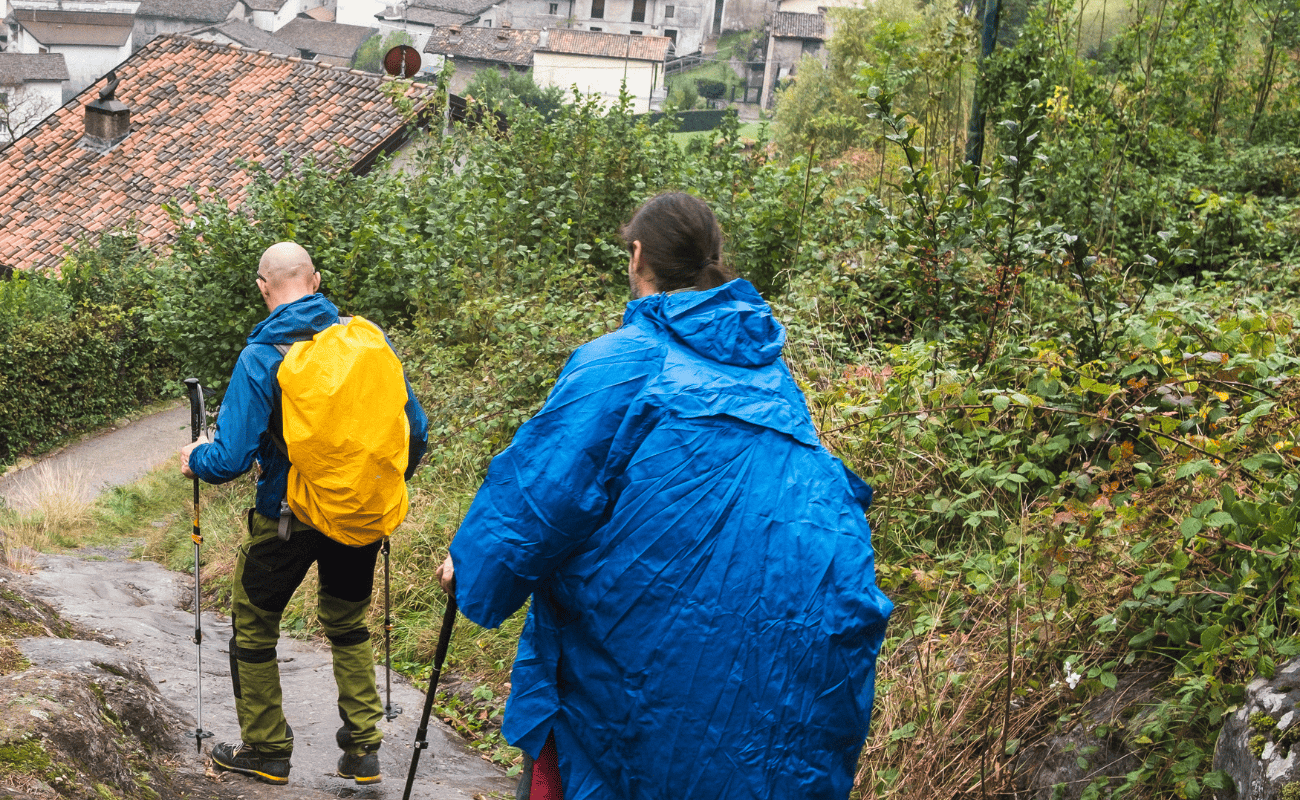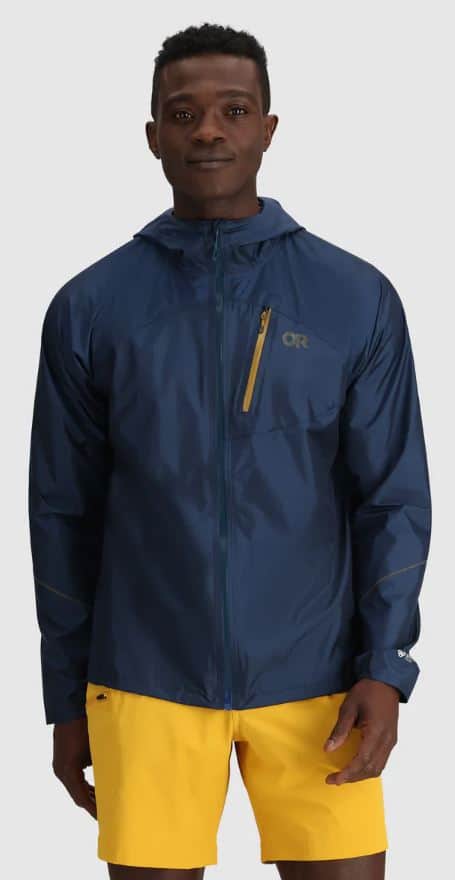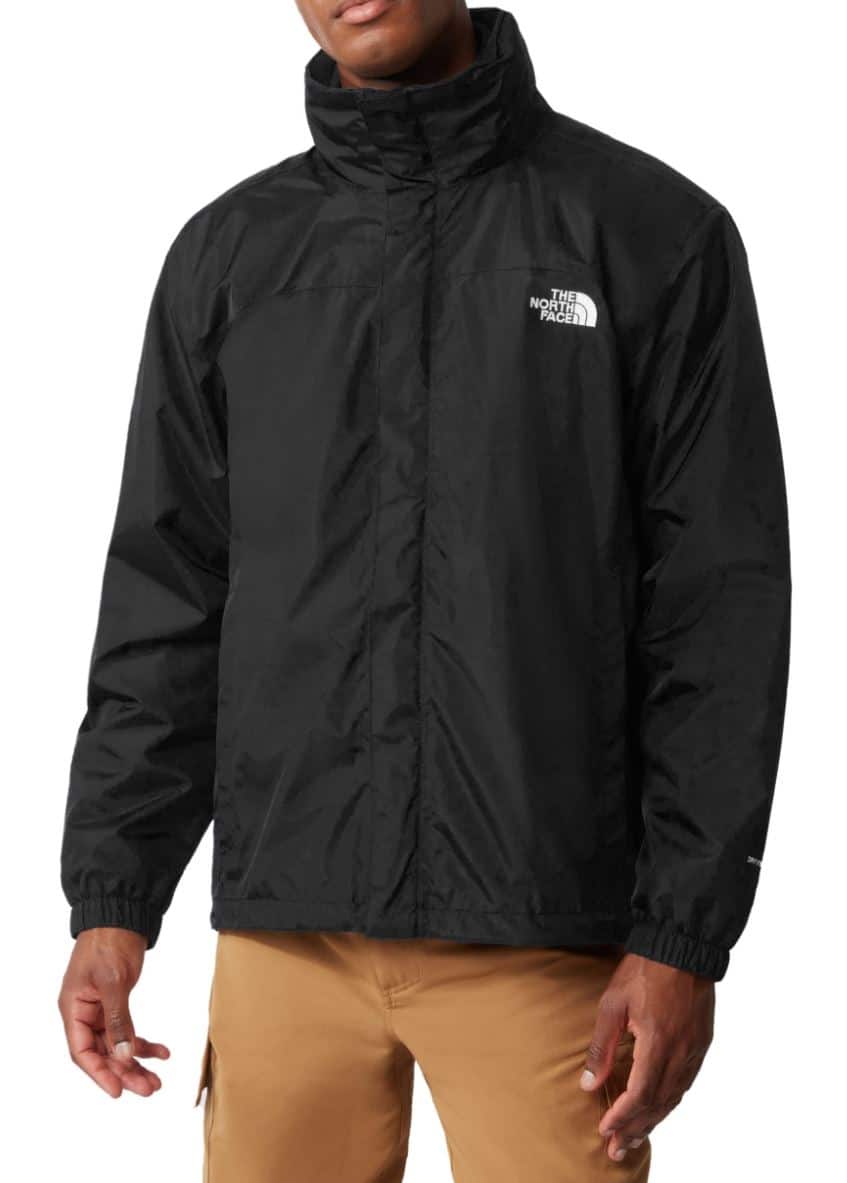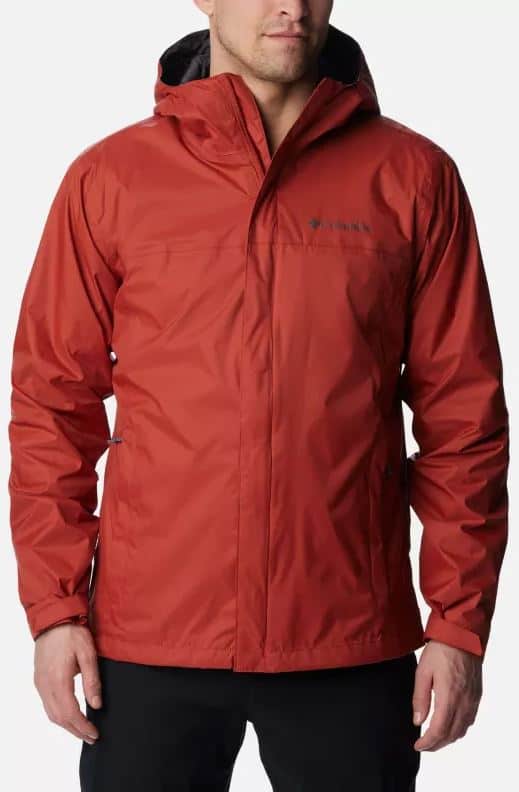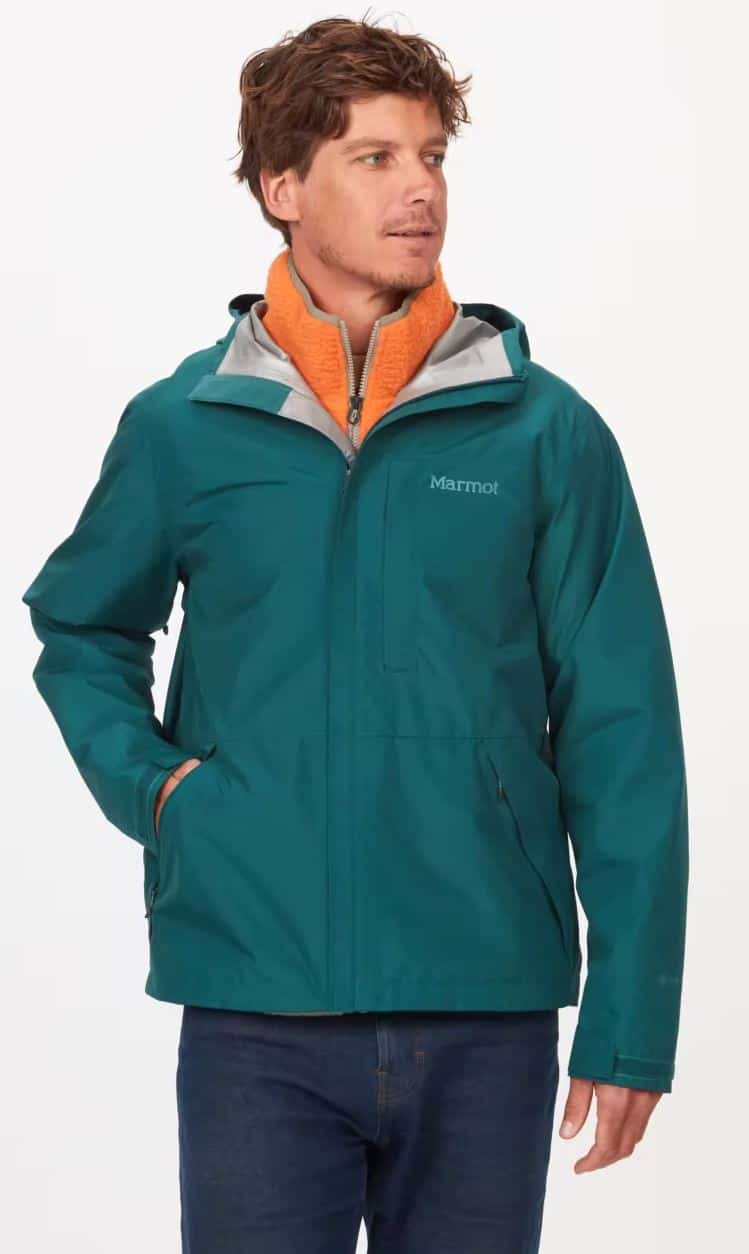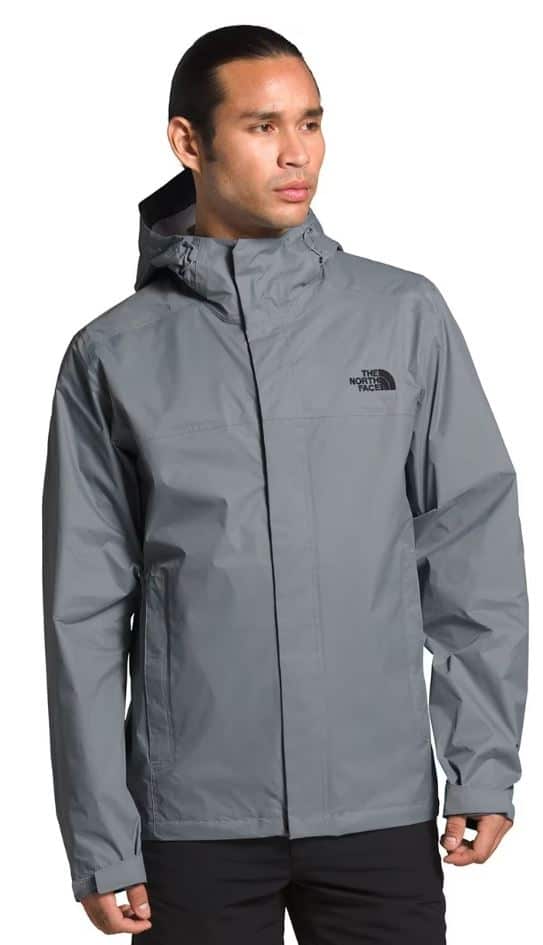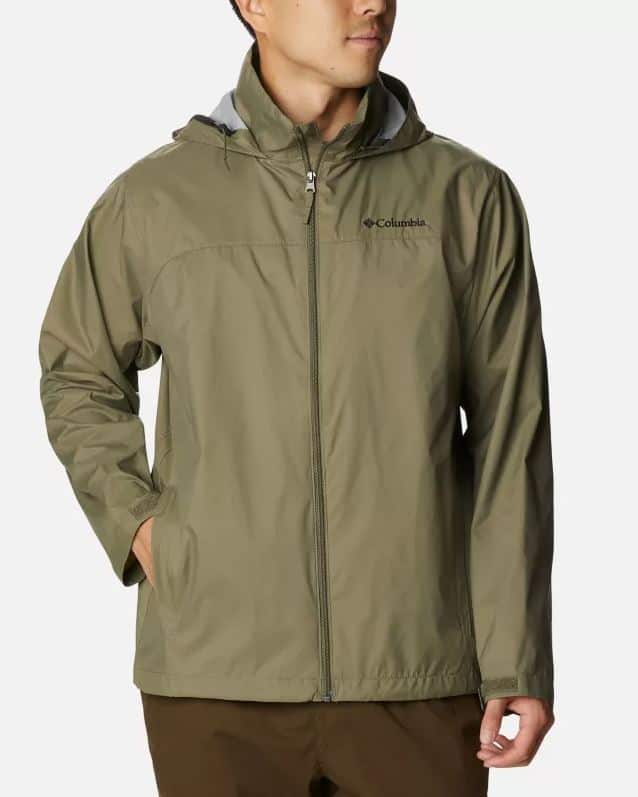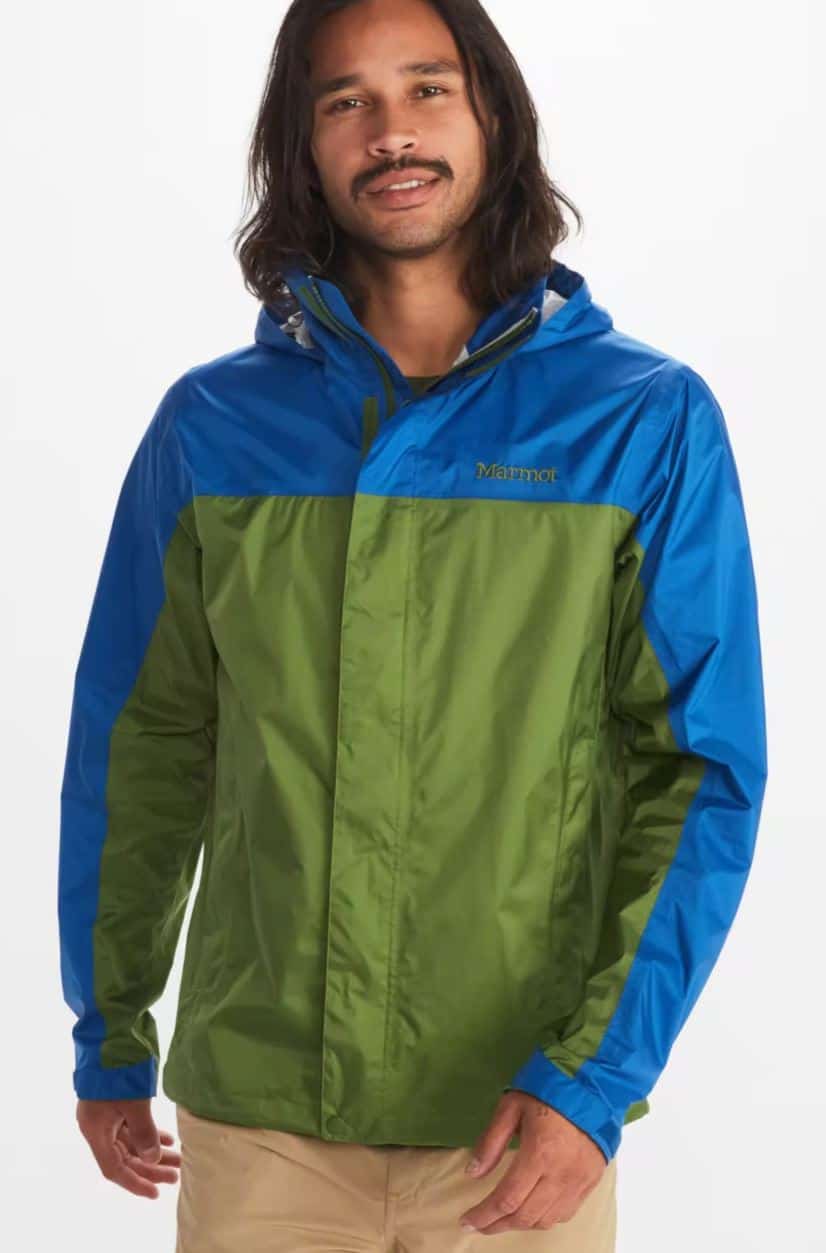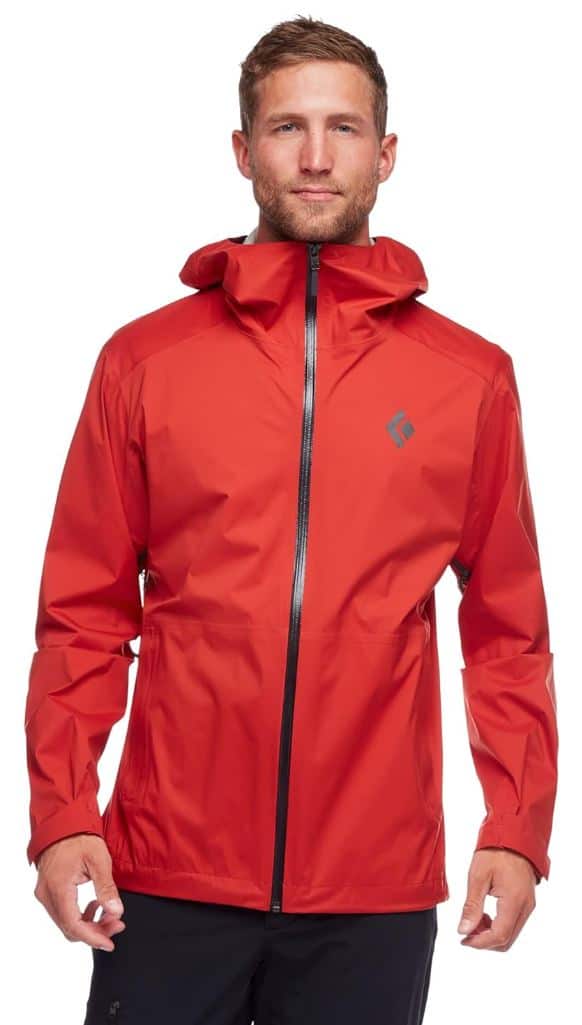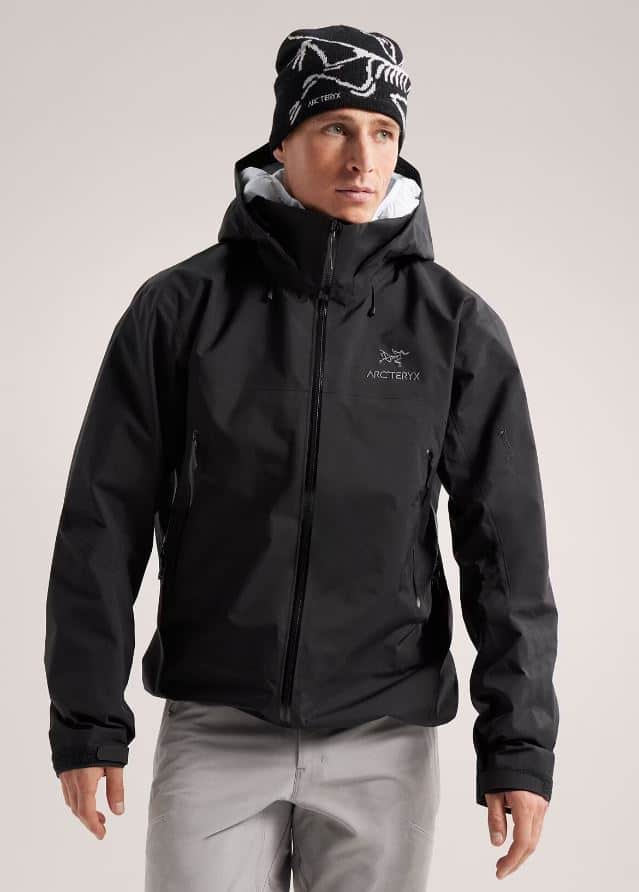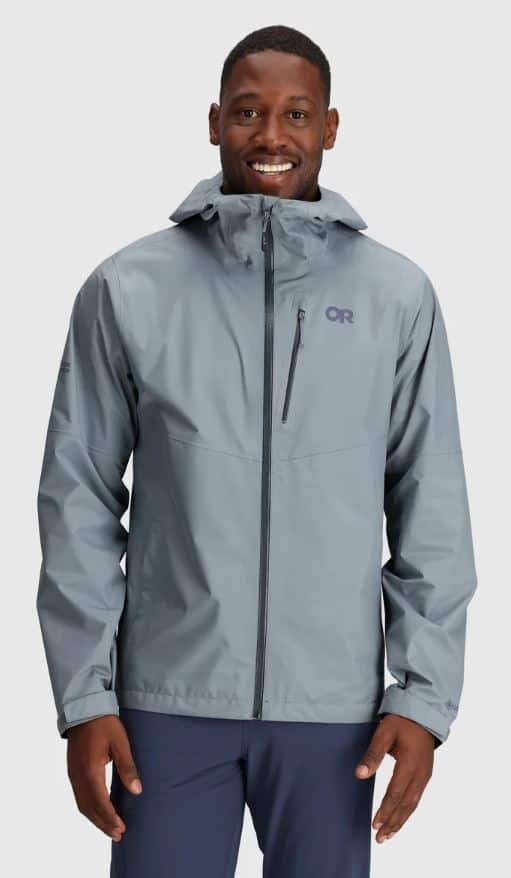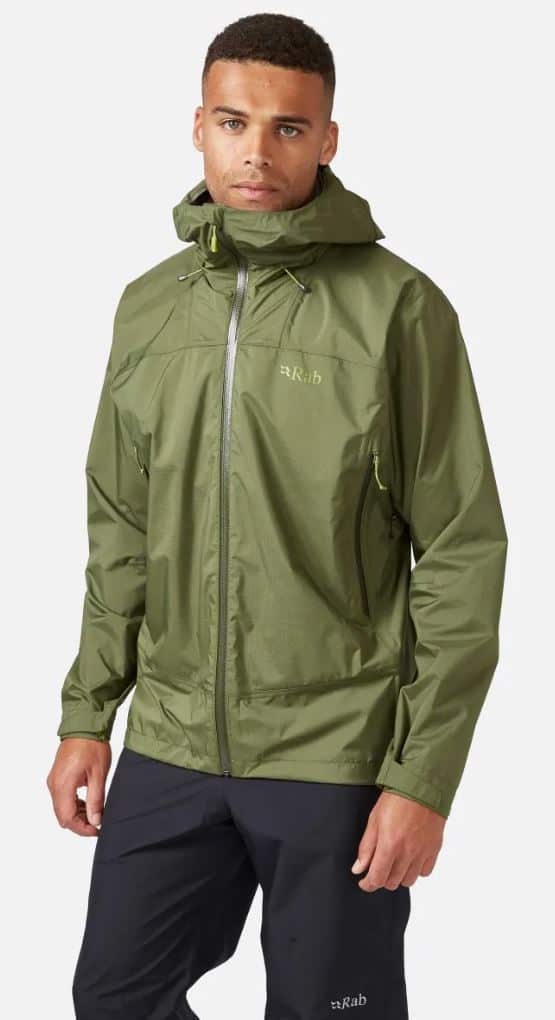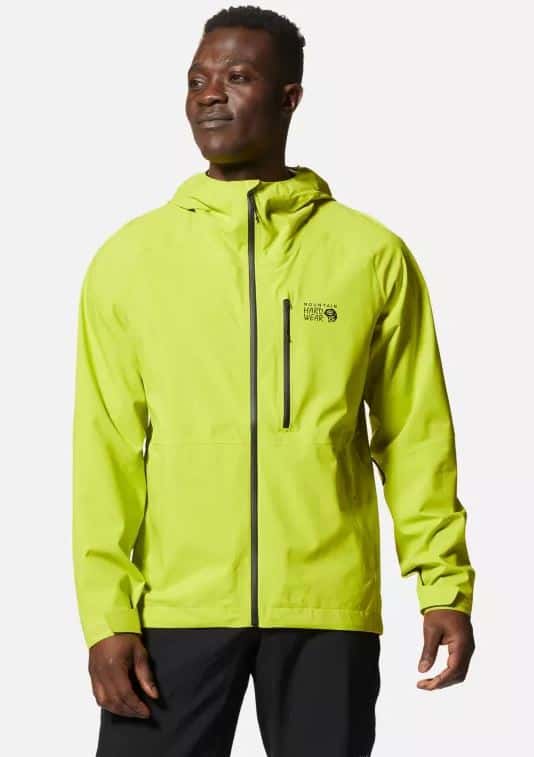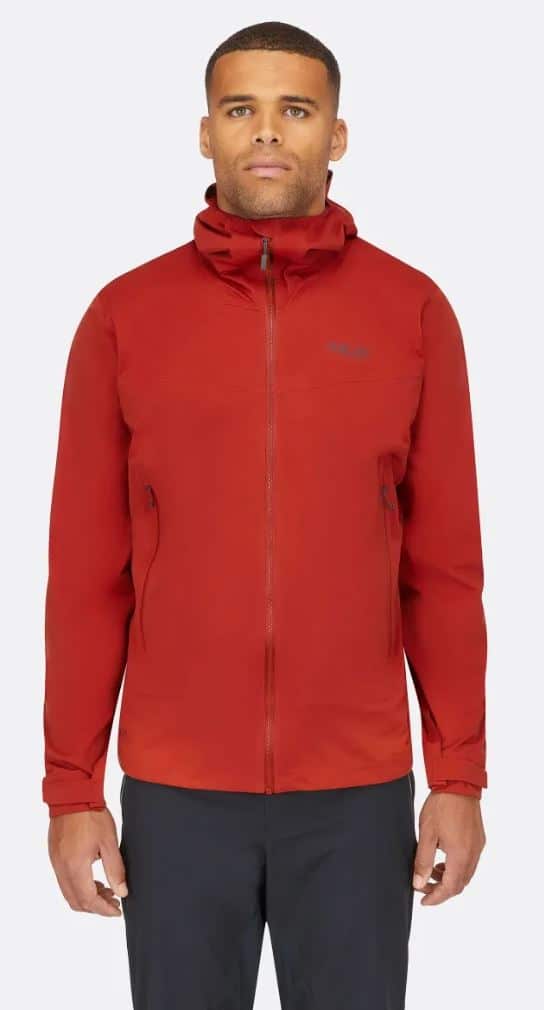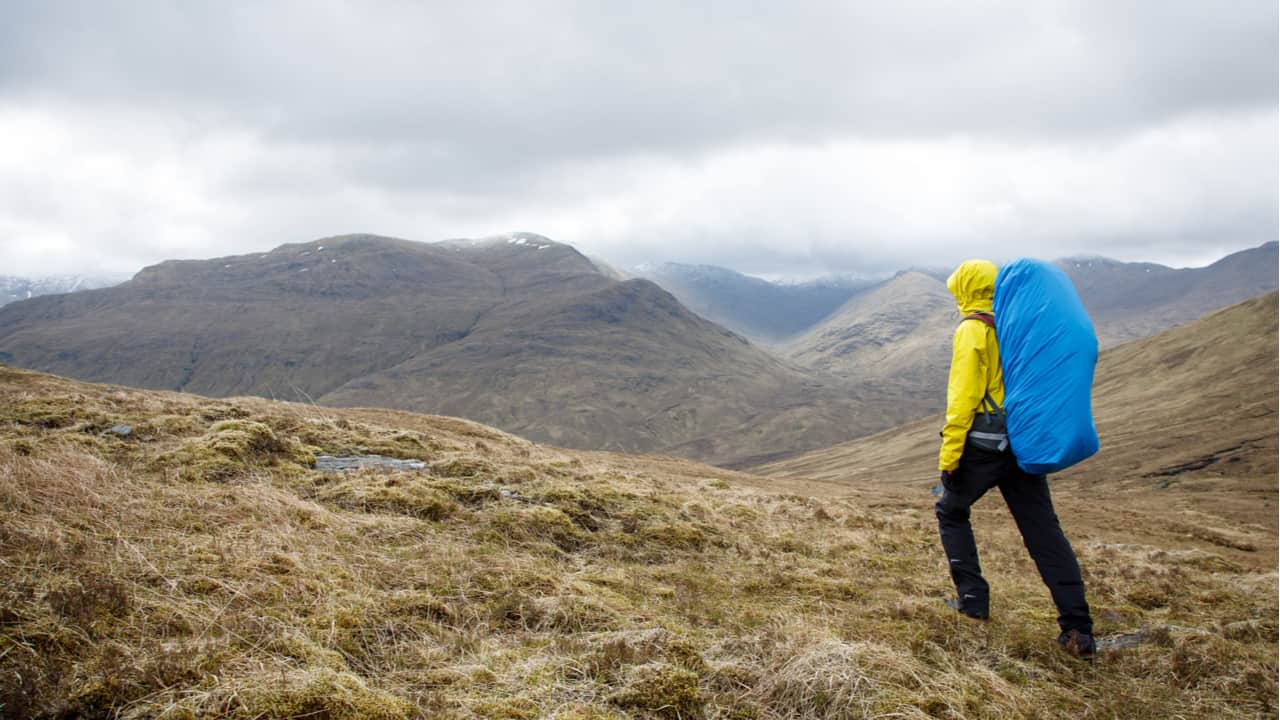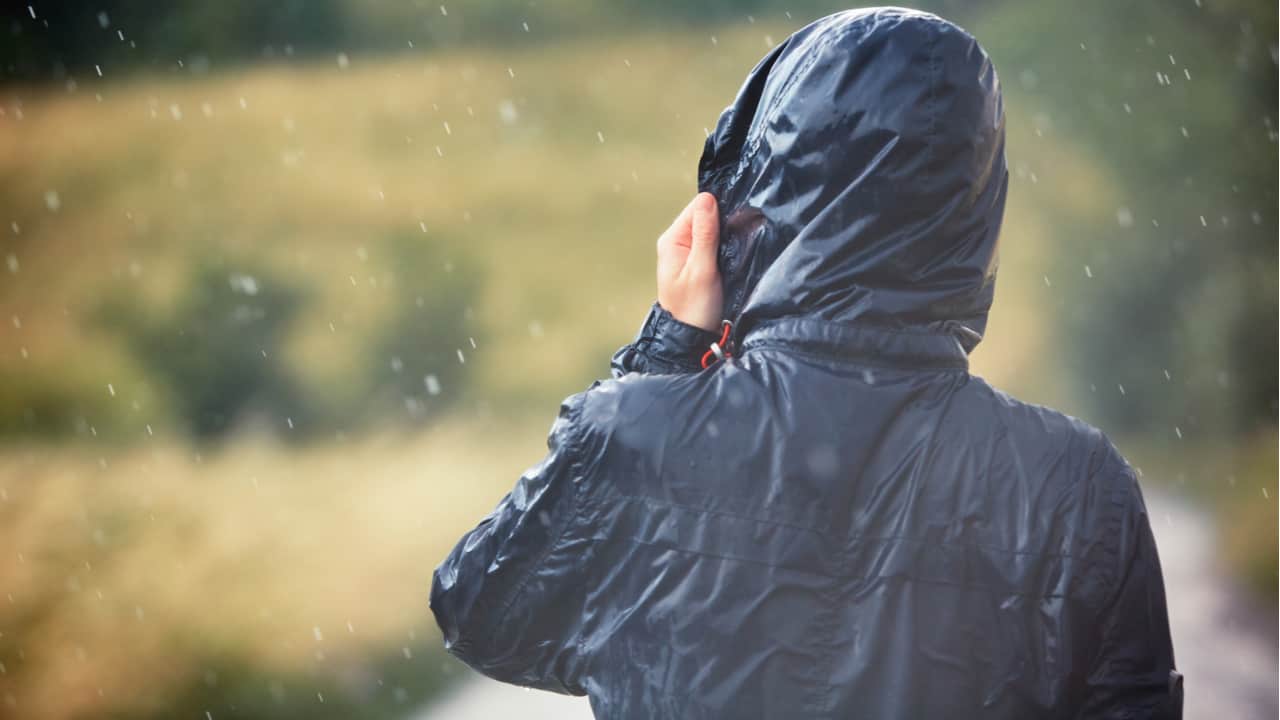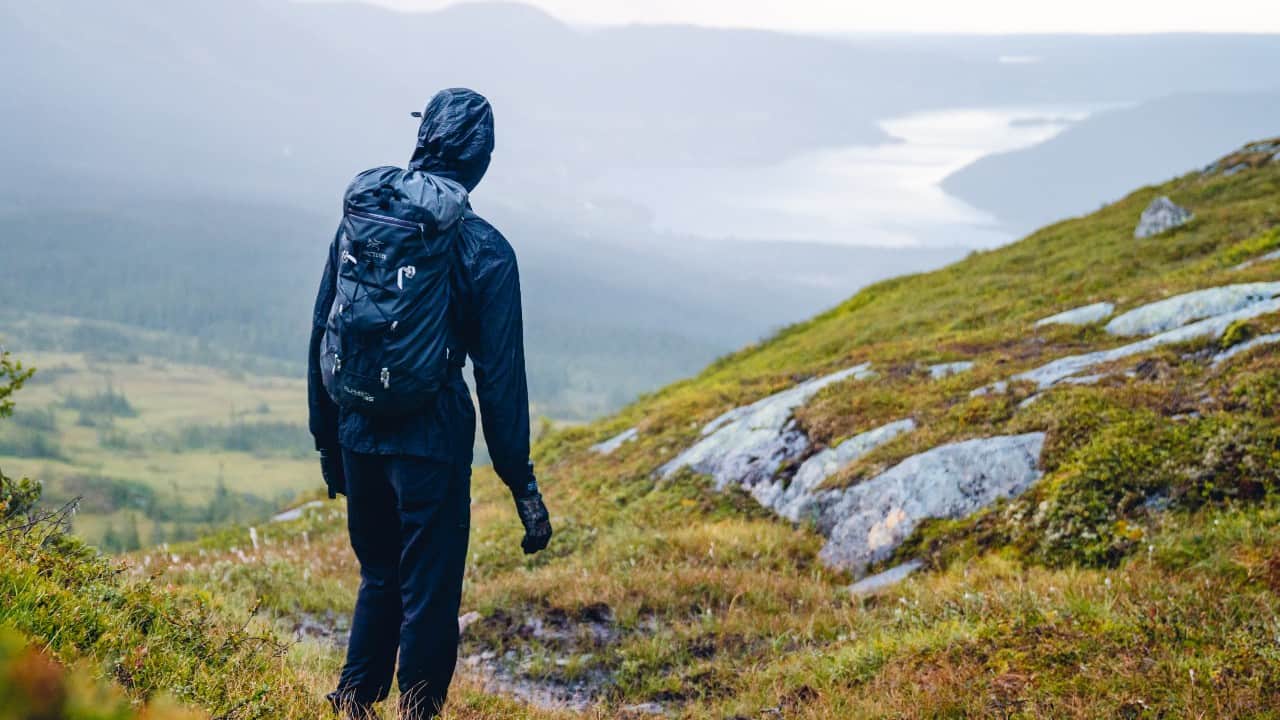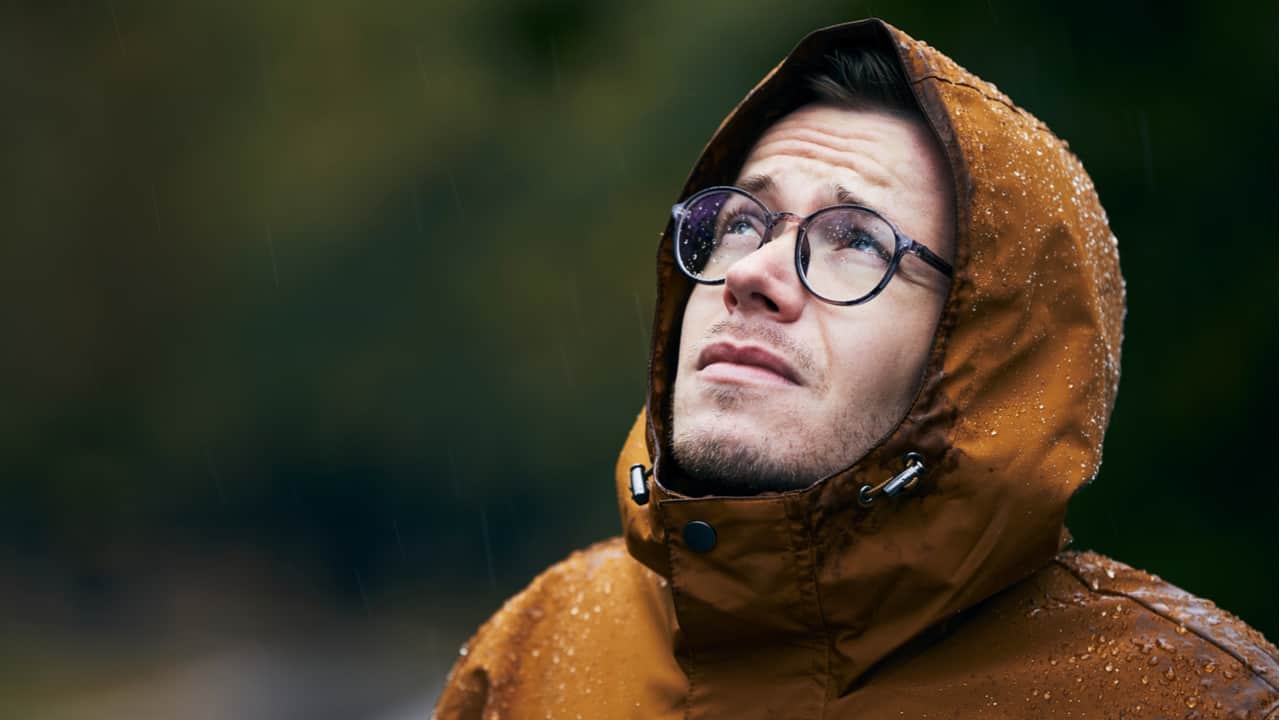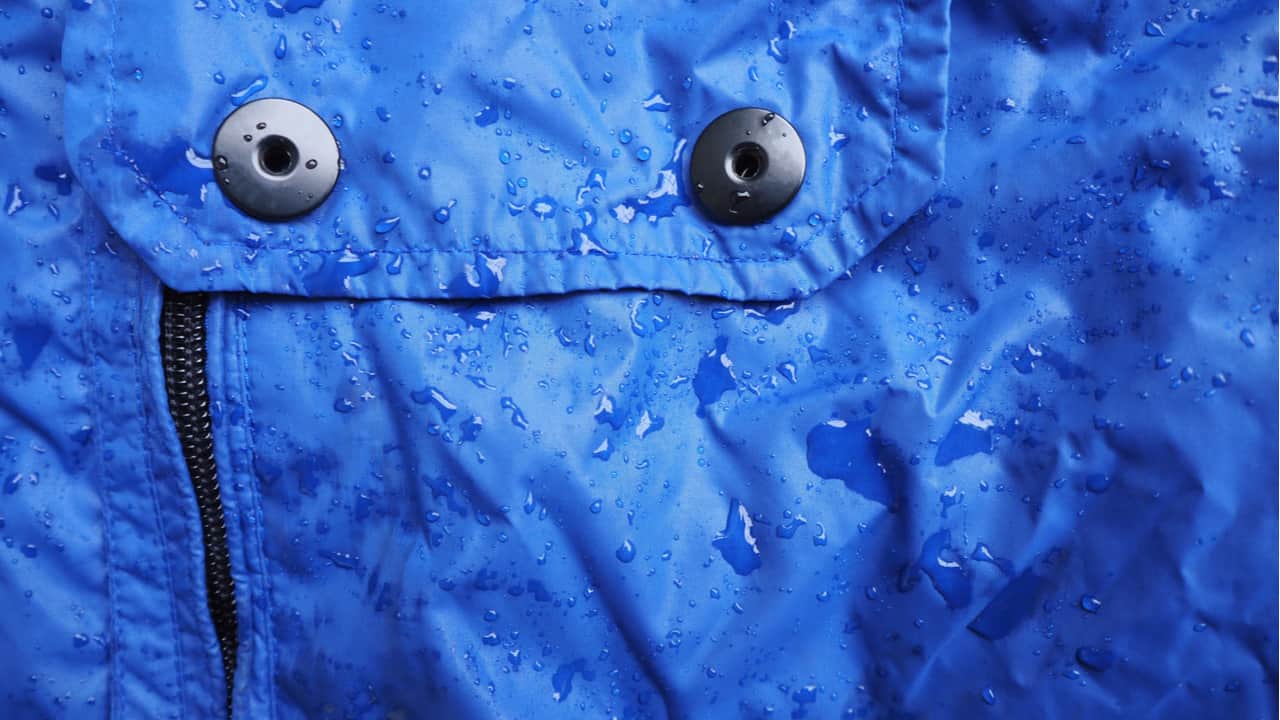It is easy to think it will be dry because the Camino de Santiago is in Spain. But it is Northern Spain, and it rains a lot the further west you walk. I always have a lightweight rain jacket in my backpack. You never know when that rain shower could happen.
You’ll want to be prepared, i.e., get yourself a good (but lightweight!) rain jacket – and these are the best the market offers.
The Quick Version
- Outdoor Research Helium Rain Jacket – Best Overall Jacket
- The North Face Resolve 2 Rain Jacket – Best Mid-Price Jacket
- Columbia Watertight II Rain Jacket – Best Budget Jacket
Lightweight Rain Jackets Reviews
Outdoor Research Helium Rain Jacket
Specifications:
- Material: 2.5L Pertex Shield Diamond Fuse, 30D ripstop nylon
- Colors available: 9
- Weight: 6.1 ounces
The first model in my roundup is Outdoor Research Helium Rain Jacket, one of the best-selling garments of this type currently available on the market.
Weighing in at a feathery 6.1 ounces, I was impressed by how light yet durable this jacket felt thanks to its Pertex Shield Diamond Fuse fabric. In testing, the Helium kept me dry in light to moderate rain showers thanks to the durable water repellant coating and its fully taped seams. Moreover, the hood was easy to adjust and covered my head well without restricting movement – a big plus for folks planning long walks like the Camino.
However, this ultralight shell did get overwhelmed in heavy downpours, with the face fabric soaking through after awhile. I also found breathability to be lacking, especially during aerobic activities where I worked up a sweat. The slippery liner failed to pull moisture away, leaving me damp and clammy on the inside.
That said, I appreciated the jacket’s packability, stuffing it easily into its chest pocket to a size not much larger than any of my windbreakers. Furthermore, the trim cut allowed for layering without looking bulky.
At just 6.1 oz with impressive toughness, the Helium is a featherweight shell that excels as an emergency rain layer for summer hiking and biking.
If you’re interested in the Helium II model, I suggest you also check out my Helium HD vs Helium II comparison.
PROS:
- Ultralight design at only 6.1 ounces
- Surprisingly durable 30D face fabric
- Effective waterproofing in light to moderate rain
CONS:
- Face fabric overwhelmed in heavy rain
- Poor breathability leads to clamminess
- No venting options besides front zipper
The North Face Resolve 2 Rain Jacket
Specifications:
- Material: DryVent nylon, polyester mesh, polyester taffeta, fleece
- Colors available: 2
- Weight: 16.2 ounces
Coming at an affordable price, the North Face Resolve 2 Rain Jacket is an excellent option for those on a budget.
The first thing I noticed was the model’s rugged 70D nylon face fabric – it’s far burlier than other models and built to withstand abuse. The jacket kept me dry thanks to its DryVent shell and full fleece-lined collar that stopped rain from dripping down my neck.
However, breathability was lacking for high energy activities due to the solid inner mesh lining. And while the jacket features two zippered hand pockets, they lack the ability to stuff the jacket inside for packing. At 16.2 ounces, the Resolve is also quite heavy.
But what it lacks in weight and breathability, the model makes up for in durability and comfort. The fleece collar and lining makes this a great cool weather jacket for casual use.
It’s not the most versatile, but provides good rain protection at a wallet-friendly price. I recommend checking out my the North Face Resolve and Venture comparison – maybe the latter model is more up your alley.
PROS:
- Rugged and durable construction
- Fleece-lined collar adds comfort
- Budget-friendly price point
CONS:
- Poor breathability
- Bulky and heavy at 16 oz
- Hand pockets don’t allow stowing jacket
Columbia Watertight II Rain Jacket
Specifications:
- Material: Omni-Tech™, DWR, plain-weave nylon
- Colors available: 37
- Weight: 13.7 ounces
Columbia is a good brand – there’s no doubt about that – so I’ve decided to put their immensely popular Watertight II Rain Jacket on the test.
This budget-friendly jacket kept me dry during light rain thanks to its 2-layer Omni-Tech waterproof shell and exceptional DWR coating that beads water well (read more about Omni-Tech and Gore-Tex technology here).
However, after an hour of downpour, water started soaking through the seams on the hood and cuffs. Breathability was also lacking – without pit zips, I overheated quickly during aerobic activity as the mesh-lined hand pockets offered little ventilation.
On the plus side, the tough-feeling nylon held up well after multiple wears, and I was impressed by the coverage and adjustability of the hood.
Packed down, the jacket stuffs into its pocket to the size of a Nalgene. What is more, the model’s roomy fit allowed for layering, though I must admit that the baggy shape wasn’t ideal for high-output use.
Ultimately, the Watertight II is a serviceable rain jacket for casual around-town wear, but performs poorly compared to premium options. It offers decent water resistance for a very wallet-friendly price, but I’d recommend upgrading if you’re planning on walking one of the longer Camino routes.
PROS:
- Great value
- Durable face fabric
- Functional hood coverage
CONS:
- Soaked through at seams
- Lacks breathability
- Boxy shape not ideal for all activities
Marmot Gore-Tex Minimalist Rain Jacket
Specifications:
- Material: 2.5L Gore-Tex Paclite, recycled polyester
- Colors available: 2
- Weight: 13 ounces
As its full name suggests, Marmot’s Minimalist Rain Jacket features Gore-Tex technology.
I was thoroughly impressed by its storm-ready performance – the durable face fabric and DWR coating shed rain and wind effectively thanks to the 2.5-layer waterproof construction. During testing, I stayed dry in downpours thanks to the model’s fully taped seams and water-resistant zippers.
However, the jacket leaves a lot to be desired in terms of breathability, even though it features handy pit zips. Moreover, at 13 ounces, this feature-rich shell is quite heavy and bulky for its name, lacking a stuff pocket for packing.
But what the Minimalist lacks in weight, it makes up for in quality: Marmot didn’t cut corners, using premium materials like sticky Velcro and glove-friendly zip pulls. The generous fit allowed me to easily layer midlayers, and I loved the tall collar and helmet-compatible hood with its stiff brim.
While not the best for aerobic activity, Marmot Gore-Tex Minimalist Rain Jacket is a versatile year-round garment with impressive weather protection considering its affordable price.
PROS:
- Proven Gore-Tex waterproofing at a great price
- Storm-ready features like adjustable hood and covered pockets
- Durable face fabric built to last
CONS:
- Heavy and bulky for its name at 13 ounces
- Lacks breathability during aerobic activity
- No stuff pocket for packing
The North Face Venture 2 Rain Jacket
Specifications:
- Material: 2.5-layer DryVent, 40D ripstop nylon
- Colors available: 12
- Weight: 11.6 ounces
Coaming at a genuinely affordable price, the North Face Venture 2 Rain Jacket is a budget-friendly shell that kept me dry thanks to its effective 2.5-layer DryVent fabric and durable water repellent finish.
During testing, it withstood moderate rain and wind, although it’s not quite as high-performing as some similarly-priced models. Breathability was also just average – the updated Venture 2 felt less suffocating than its predecessor during aerobic activity thanks to repositioned pit zips, but ventilation still wasn’t its strong suit.
On the bright side, I was impressed by the Venture’s tough 40D ripstop exterior, which proved more abrasion-resistant than (most) competitors. The jacket’s hood also provided great adjustability thanks to its roomy fit and rear cinch cord. Packed down, it stuffs into its pocket to a reasonably small size – a fantastic feature for anyone planning to walk the Camino.
For the price, the Venture 2 performs admirably as a budget shell layer for light hiking and urban use. It’s reasonably weather resistant and comfortable, if not exceptionally breathable.
PROS:
- Wallet-friendly price under $100
- Durable face fabric built to last
- Effective hood adjustment system
CONS:
- Lacks high-output breathability
- Fit runs slightly loose and bulky
- Not helmet-compatible
Columbia Glennaker Rain Jacket
Specifications:
- Material: Omni-Tech™, Hydroplus nylon
- Colors available: 39
- Weight: 11.2 ounces
I recently tested Columbia’s Glennaker Rain Jacket that I purchased for a very low price.
Weighing next to nothing, this packable shell has kept me dry during light rain showers thanks to its waterproof Omni-Shield fabric. I’ve worn it over my puffy jacket on blustery peaks, where it blocked wind effectively, trapping precious body warmth. The jacket stuffs into its own pocket for compact transport.
However, it failed to keep me dry in a heavy downpour. I also noticed some leakage through the seams. Furthermore, this particular Columbia jacket lacks venting options, which caused me to overheat quickly while hiking. I ended up adding my own zipper pulls to the bare zippers which were pretty difficult to grasp with gloves on.
But for the incredibly budget-friendly price, the Glennaker performs respectably well – it’s great for casual around-town wear and moderate hikes in iffy weather (and, therefore, not the best choice if you’re planning to walk for tens of miles every day on the Camino).
I also have to add I’ve appreciated the handy stowable hood and the jacket’s overall lightweight feel, even if its build quality means it probably won’t last through years of heavy use. But as a backup shell coming at a low price, it certainly gets the job done.
PROS:
- Extremely affordable
- Packable and lightweight
- Blocks wind to retain heat
CONS:
- Not waterproof in heavy rain
- No venting leads to overheating
- Need to add own zipper pulls
Marmot PreCip Eco Rain Jacket
Specifications:
- Material: Marmot NanoPro recycled nylon, DWR
- Colors available: 28
- Weight: 10.3 ounces
Marmot’s PreCip Eco Rain Jacket is yet another budget-friendly option in my roundup, a model that impresses with its latest sustainable makeover.
The updated shell now uses recycled nylon and a PFC-free DWR coating, but still packs proven weather protection. During testing, the PreCip Eco’s 2.5-layer NanoPro fabric kept me dry in all but the most torrential downpours. I also appreciated the pit zips for ventilation when working hard, although the interior still felt rather clammy.
At 10.3 ounces, the jacket remains pleasingly lightweight and packs down small into its stuff pocket. After several years of use across various trips and daily wear, my older PreCip is just starting to show some wear, so I guess the same will apply to this updated variant – Columbia’s jackets are much more durable than most people think.
With an adjustable hood, quality zippers, and thoughtful eco-friendly updates, the versatile PreCip Eco Rain Jacket continues to hit that sweet spot between budget and performance.
PROS:
- Proven waterproofing at an excellent price
- Packable and lightweight at 10.3 ounces
- Now made with recycled nylon and PFC-free DWR
CONS:
- Can feel clammy next to skin when active
- Thin fabric gets overwhelmed in downpours
- Velcro quality not the most durable
Black Diamond Stretch Rain Jacket
Specifications:
- Material: BD.dry face fabric, DWR
- Colors available: 1
- Weight: 11.29 ounces
Black Diamond’s Stretch Rain Jacket is a lightweight shell that managed to impress me with its added stretch and mobility thanks to the elastic face fabric.
Despite the 2.5-layer build, the BD.dry membrane and DWR coating provided reliable weather protection even in lengthy Scottish downpours – I’m pretty sure the model would easily withstand any kind of rainfall in Northern Spain. I stayed dry while hiking and biking in this jacket, although breathability was only moderate during aerobic output.
I appreciated the roomy pit zips for ventilation. Moreover, packed down, the model easily stuffs into its pocket for compact transport. Finally, after extensive testing across various wet adventures, I can attest that the jacket showed minimal signs of wear.
Overall, the thoughtfully designed Stretch Rain Jacket hits a nice balance between weather protection, weight, features, and affordability. I’d recommend it as a do-anything rain jacket for hiking, biking, and even climbing.
PROS:
- Lightweight with good feature set
- Stretchy fabric increases comfort and mobility
- Resists saturation and wetting out in rain
CONS:
- Lacks breathability during aerobic activity
- Hand pocket lining feels sticky when damp
- Boxy men’s fit not ideal for layering
Arc’teryx Beta AR Rain Jacket
Specifications:
- Material: Gore-Tex Pro, N80d 3L fabric
- Colors available: 4
- Weight: 15.6 ounces
Constructed with durable yet reasonably lightweight Gore-Tex Pro, the Arc’teryx Beta AR Rain Jacket provides impressive weather protection thanks to an N80d 3L shell and fully taped seams.
During testing in harsh weather conditions, this versatile hardshell jacket kept me completely dry – weatherproofing is not something you need to worry about with Arc’teryx apparel. Breathability was just average, though, even with the large pit zips.
After weeks of use across various adventures, I’ve been continually impressed by Arc’teryx’s attention to detail and quality construction. I especially appreciated design touches like the harness-compatible hand pockets and helmet-ready DropHood with laminated brim.
Moreover, at 15.6 ounces, the Beta AR remains lightweight enough for all-day wear. It also allows a full range of motion when skiing or climbing, thanks to its articulated cut.
While a bit pricey, the Arc’teryx Beta AR is a confidence-inspiring year-round shell that can withstand brutal mountain weather.
PROS:
- Bomber weather protection with Gore-Tex Pro
- Durable yet reasonably lightweight at 15.6 ounces
- Excellent mobility and articulated fit
CONS:
- One of the most expensive jackets on the list
- Breathability is just average
- Shorter back length for skiing use
Outdoor Research Foray II Rain Jacket
Specifications:
- Material: 2L Gore-Tex Paclite, 50D polyester
- Colors available: 9
- Weight: 12 ounces
The Outdoor Research’s Foray II Rain Jacket is constructed with 2-layer Gore-Tex Paclite and provides stellar waterproofing in wet weather.
Despite the model’s budget-friendly membrane, the 50D face fabric felt surprisingly durable. The Foray II kept me truly dry in torrential downpours thanks to its fully taped seams and water-resistant zippers.
However, as with many other jackets in this roundup, Foray’s breathability was only moderate, with the lining growing clammy during aerobic output. Thankfully, the signature TorsoFlo side zips run the full length of the jacket, offering awesome venting potential.
At 12 ounces, the updated Foray II also weighs over 4 ounces less than its predecessor while retaining core features like an adjustable hood and harness-ready hand pockets. After miles on the trail and ski slopes, I’ve been impressed by the jacket’s toughness and weather resistance.
It’s a versatile year-round shell for hiking and backpacking, including long-distance walks like the Camino de Santiago. While on the topic of OR jackets, I highly recommend checking out my Outdoor Research vs The North Face comparison.
PROS:
- Bomber weather protection with 2L Gore-Tex
- Innovative full-length venting zips
- Surprisingly durable 50D face fabric
CONS:
- Clamminess next to skin when active
- Uneven hem cinch in back
- No 2-way zipper for packing
RAB Downpour Plus 2.0 Rain Jacket
Specifications:
- Material: 2.5-layer Pertex Shield, recycled 40D polyamide, DWR
- Colors available: 5
- Weight: 13.2 ounces
The Rab Downpour Plus 2.0 Rain Jacket is a versatile shell that utilizes trusted 2.5-layer Pertex Shield fabric with a 20K waterproof rating – a construction that kept me dry during a few wet spring adventures.
During urban commutes and mountain bike rides alike, the jacket withstood everything from drizzles to downpours thanks to fully taped seams and an effective DWR coating. Breathability rated at 20K proved adequate, with the generous pit zips helping to dump heat and moisture when working hard.
Weighing 13.2 ounces, the Downpour Plus 2.0 Rain Jacket wasn’t the most lightweight rain jacket I’ve tested but had a nicely trim fit for mobility. Well-designed features like a helmet-compatible hood, harness-ready zippered pockets, and glove-friendly pull tabs further boosted functionality.
In summary, I was impressed by this jacket’s optimal balance of waterproofing, breathability, weight, and smart features. It’s an excellent choice for the Camino.
PROS:
- Total waterproofing for the price
- Generous pit zips enhance ventilation
- Thoughtful features and streamlined fit
CONS:
- Left-handed front zipper takes adjustment
- Can feel clammy when working hard
- Not as lightweight as specialty shells
Mountain Hardwear Stretch Ozonic Rain Jacket
Specifications:
- Material: 50D Dry.Q proprietary fabric, DWR, polyester
- Colors available: 10
- Weight: 10.5 ounces
The highly mobile shell of the Mountain Hardwear’s Stretch Ozonic Rain Jacket utilizes a proprietary 50D Dry.Q stretch fabric. Despite the light 2.5-layer build, it kept me reasonably dry in light to moderate rain.
However, during heavy downpours, moisture saturated the model’s thin face fabric. On the bright side, breathability was above average thanks to effective wicking from the soft interior lining. I stayed comfortable hiking and climbing in the jacket, although the thin hood pinched my ears when overtightened.
The Stretch Ozonic weighs 10.5 ounces and ranks among the most lightweight models I tested, easily packing down into its pocket.
While storm protection doesn’t match burlier shells, I appreciated the Ozonic’s superb freedom of movement thanks to its stretchy fabric. For aerobic pursuits like hiking, climbing, and ski touring that demand mobility, this thoughtfully garment is a home run. But I’d recommend it for fair weather use rather than storms.
PROS:
- Highly mobile stretch fabric
- Surprisingly good next-to-skin comfort
- Very lightweight and packable
CONS:
- Wets out in heavy rainfall
- Thin hood can pinch ears
- Lacks harness-ready pockets
RAB Kinetic 2.0 Rain Jacket
Specifications:
- Material: Recycled Proflex fabric
- Colors available: 7
- Weight: 12 ounces
The last model in my roundup of the market’s most popular lightweight rain jackets is the remarkably stretchy Rab Kinetic 2.0 Rain Jacket.
This athletic shell utilizes proprietary Proflex fabric that proved twice as elastic as the next stretchiest jacket I tested. Despite the air-permeable build, it kept me reasonably dry hiking in light rain thanks to a polyurethane membrane and tight exterior knit.
However, during extended wet spells, moisture saturated the exterior. Fortunately, the model’s breathability matched softshells, enhanced by the cozy brushed lining that never felt plasticky or clammy. The unique 2-part hood also maintained visibility while keeping out moisture.
As it weighs 12 ounces, the Kinetic 2.0 isn’t ultra light, but it moved effortlessly thanks to clever articulation and superb mobility. After testing in various aerobic exploits, I was pretty much blown away by the unencumbered freedom of motion.
For high-output activities – like walking the Camino – the thoughtfully designed Kinetic 2.0 is a great choice. Still, keep in mind that its storm protection doesn’t match burlier shells.
PROS:
- Unmatched stretch and mobility
- Surprisingly good next-to-skin comfort
- Two-part hood enhances coverage
CONS:
- Wets out in sustained rainfall
- Slim fit limits layering
- Pricier than basic rain jackets
Best Lightweight Rain Jacket Buying Guide
If you are buying a rain jacket for the Camino de Santiago (see my Camino packing list) or another long-distance hike, the most important feature is that the jacket will last. Additionally, the jacket must be thick enough to last a long time, with the backpack rubbing against it all day.
You’ll find that every rain jacket is water-resistant to some extent. The question is, what degree of protection against the elements does the model in question offer?
Water-Resistant vs Waterproof
When a jacket can keep out driving rain without any problems, it’s called “waterproof.” Brands disagree on test standards, so not all waterproof shells are made equal. If a jacket is suspiciously cheap and labeled “waterproof,” something may be amiss.
However, backpacking rain jackets from major brands such as Patagonia and Outdoor Research can withstand serious downpours.
Water-resistant
Some rain jackets can protect you from water only for a brief time. These are not waterproof, only water-resistant. A water-resistant jacket won’t be up to the task if raindrops linger on the shell or if you get caught in a heavy downpour.
Breathable/waterproof
If you prefer a specific type of fabric or want something you’ve never tried before, you may opt for a Gore-Tex jacket or another jacket that uses a proprietary waterproof and breathable membrane (such as H2No or Futurelight). These materials have been used for years to keep outdoor enthusiasts warm while keeping the rain and wind out. Gore-tex has pioneered the technology of making breathable and waterproof fabrics.
Non-breathable/waterproof
Think emergency poncho or rain slicker. This type of rain jacket is fine if you need something to keep the rain out while standing around or sitting somewhere; it is not for hiking.
Wind-resistant vs Windproof
“Wind-resistant” relates to “windproof” the same way “water-resistant” relates to “waterproof.” Let’s take the threshold REI has established for its rain jackets as an example: a rain jacket is windproof when it can stand up to winds stronger than 60 mph.
Wind-resistant
Most ultralight rain jackets are only wind-resistant. A wind-resistant jacket easily stuffs into a pocket. Such a rain jacket won’t offer much protection in a storm, but it’s excellent for day hikes.
Windproof
Most waterproof jackets are windproof as well. The barrier blocks the wind that pushes the rain and the driving rain. However, some shells feature a laminate that is windproof but only water-resistant.
Lightweight Jacket Construction
3-in-1 Jackets
A 3-in-1 waterproof jacket combines an insulated shell with a fleece jacket, a step beyond your everyday rainwear. This allows one to wear either piece on its own. The inner layer usually zips into the rain jacket.
Rain Jacket Layers
While jacket construction will vary between manufacturers, rain jackets typically have 2 or 3 layers. Along with face fabric and a membrane, many jackets also have a backing that helps your body breathe. If you want as much protection as possible, you should opt for a jacket that comes with three layers.
2-Layer Jackets
The coating or membrane layer is applied inside an outer fabric to form a single piece of material. A loose-hanging line is added inside to protect the coating or the membrane.
A 2-layer construction is favored for travel and urban rain jackets because it is quieter. Moderately priced rain jackets often feature a 2-layer construction.
2.5-Layer Jackets
A 2.5-layer construction has a durable yet lightweight first layer. A coating or polyurethane layer is inside the first layer (second layer). A “half layer,” essentially a protective print or sheen, is applied over that second layer.
Generally, 2.5-layer jackets are light and affordable, but they don’t match the durability or breathability of 3-layer jackets. Many people used to complain that 2.5-layer jackets feel too clammy. To prevent this, high-end outdoor brands have started using “dry touch” prints.
3-Layer Jackets
A 3-layer construction features a waterproof membrane tightly sandwiched between a liner and a rugged face fabric. A 3-layer rain jacket doesn’t feature a coating.
3-layer jackets are great for hiking and backpacking in the harshest environments. But 3-layer jackets are also the most expensive of the three types.
Breathability
No one wants to go hiking in a wearable sauna. When I talk about breathability, I really mean “moisture vapor transfer.” Breathable jackets rely on the fact that the moist, warm air inside is attracted to the drier, colder air outside.
How clammy or dry you feel depends on the efficiency of this vapor transfer process. Outdoor brands have been focusing on improving that efficiency in recent years, so Gore-Tex fabrics are not the only reliable option on the market anymore. For instance, eVent is a waterproof/breathable fabric that comes close to Gore-Tex Paclite Plus and Gore-Tex Active.
However, it’s important to note that no independent certification body or universal test standard measures breathability. Super breathable jackets usually come with a tradeoff. They let out warm air and moisture, so you may need to wear an insulating layer underneath.
Breathable/Waterproof Technologies
A membrane or coating that allows sweat vapor to escape while blocking rain is the key component of your rainwear fabric. The technology that makes this possible is rather delicate—it involves bonding a protective fabric to a membrane to create a laminate.
While the exact materials used in each jacket vary, almost every rain shell is made using either a coating or laminate.
Coatings vs. Laminates
There is a big difference between the makeup of the coating and the makeup of laminates. The following chart provides widely accepted performance, price, and weight assessments. It is important to note that some rain shells are exceptions to these guidelines.
| Coating | Laminate | |
| Made from: | Various formulations of polyurethane (PU) | Polyester membrane, polyurethane (PU), expanded polytetrafluoroethylene (EPTFE) |
| Think of it as: | Paint spread on a wall | Wallpaper glued to a wall |
| Waterproof performance: | Good | Best |
| Weight: | Ultralight to lightweight | Lightweight |
| Durability: | Good | Best |
| Breathability: | Good | Best |
| Price: | Highest | Lowest |
DWR coating (Durable water repellent)
Most lightweight and ultralight rain jackets, even the ones that already have a waterproof/breathable membrane, feature a DWR coating. Water beads up and rolls off the surface when a rain shell has a DWR (durable water repellent) coating.
A DWR coating can’t hold up forever. It will start to wear off depending on its quality. If you want your high-tech rain shell to keep working its magic, maintenance of the DWR finish is critical.
The underlying waterproof membrane will still keep out the water, but the outer fabric will become clammy, and the jacket will become less breathable.
Today, most brands use DWR, which is more environmentally friendly. However, this type of DWR wears out more quickly than older DWR coatings.
To ensure maximum protection from water, get a DWR spray (check out my pick for the best water repellent spray) and reapply the coating every now and then. You can tell it’s time to reapply when the water stops beading on the fabric.
Rain Jacket Features
Pit Zips
During strenuous activity, even the most breathable jacket can get overwhelmed. Quality rain jackets often feature pit zips (underarm vents) that are designed to help you cool down. Some jackets also have mesh liners in check pockets for increased ventilation.
Zippers
Most rain jackets are loaded with zippers, from pit zips to the front opening to pockets. You’d want to get a jacket that has a rubberized coating or a storm flap that will keep rain from seeping through the zippers.
Laminated zippers, also known as coated zippers, need a zipper garage or a zipper hut. Essentially, it’s a cover that shields the small opening at the end of the zipper track. These zippers are harder to zip up and down. Though the coating will eventually wear down, brands have started to use this type of zipper instead of full flaps to save weight.
Hood
Not many people pay attention to the hood. However, I consider its construction vital. A hood that’s too small won’t protect you. A hood that’s too big can make it too hard to see.
This is why you must find a rain jacket with a hood that fits well. You may also want to look for a hood with a peak, as it can help keep the rain away from your face. If you want to be able to fine-tune the size of the opening, get a hood that has brims and adjustments on the sides.
Chin Guard
Not all rain jackets come with chin guards. Chin guards help to protect your face from rubbing, which I found to be very uncomfortable. They can also help prevent you from catching your chin on the waterproof fabric or the zip.
Pockets
While you may not consider pockets a vital part of your jacket, their position can affect what you use the jacket for. For example, if you plan to hike mountains, you should opt for a jacket with pockets located quite high up. Pockets should ideally be a good size to hold maps, cell phones, and anything else you need on the trail.
I want all but one pocket to be accessible from the outside, as I don’t want to unzip the jacket to reach anything except for the valuables.
Pockets that are placed away from the shoulder straps and above the hip belt are a sign of a well-thought-out design. This way, you can access the pockets while your backpack is on. Finally, in order to let wearers easily listen to music on their phones, many rain jackets now include a chest pocket with a cord port.
Seam Taping
For a rain jacket to be truly waterproof, it must be fully seam-taped. A jacket’s construction requires a lot of seams, so not all manufacturers make fully seam-taped lightweight rain jackets.
You shouldn’t assume that a rain jacket is waterproof if you see that it has taped seams on the shoulders and the hood. Usually, water-resistant jackets have fully taped seams in the hood and shoulders but nowhere else.
Packability
The best lightweight rain jackets are very easy to pack because they are made from ultralight, non-bulky fabrics. A packable rain jacket usually comes with a stuff sack or it has a pocket that doubles as a storage pouch.
Adjustment Features
Rain jackets often have a draw cord at the bottom hem and an adjustable hood. The best rain jackets also feature adjustable wrist closures. All of these features are designed to keep cold, wind, and rain from sneaking into the opening of your rain jacket.
Durability
Lightweight rain jackets are not as durable as more traditional waterproof jackets. But if you want to get a rain jacket that will last longer, get a model with a higher-denier face fabric. Denier measures the fiber thickness of individual filaments (or threads) in the fabric.
Jackets with a high-denier face fabric (50D) are thicker and more abrasion-resistant. Fabrics with a low denier (20D or lower) are soft and less durable.
If you are going hiking and backpacking in rocky or thick brush areas, it’s best to get a higher-denier rain jacket.
Most lightweight rain jackets feature low-denier fabrics. This makes them easy to pack and easy to carry, but they tear more easily if they come into contact with jagged rock, thick brush, or branches.
Rain Jacket or Poncho?
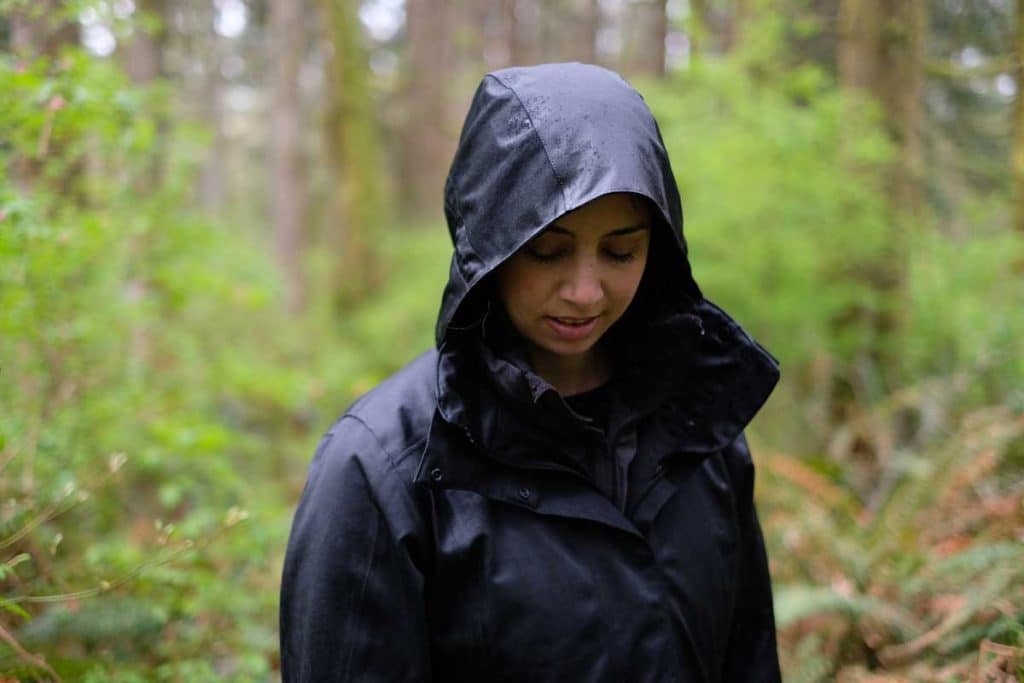
She used it all the way along the French Camino de Santiago and Camino Le Puy. In some downpours, her backpack has stayed dry, while mine has been a little damp.

I love hiking, backpacking, and camping. From the Camino de Santiago to the West Highland Way in Scotland or simply a great day hike on the weekend. Hiking refreshes me, my mind, and keeps my body reasonably fit. So far I have walked three Camino routes and many other long distance hikes in the UK, Canada, and around the rest of Europe. One of the best was my hike up Ben Nevis.

